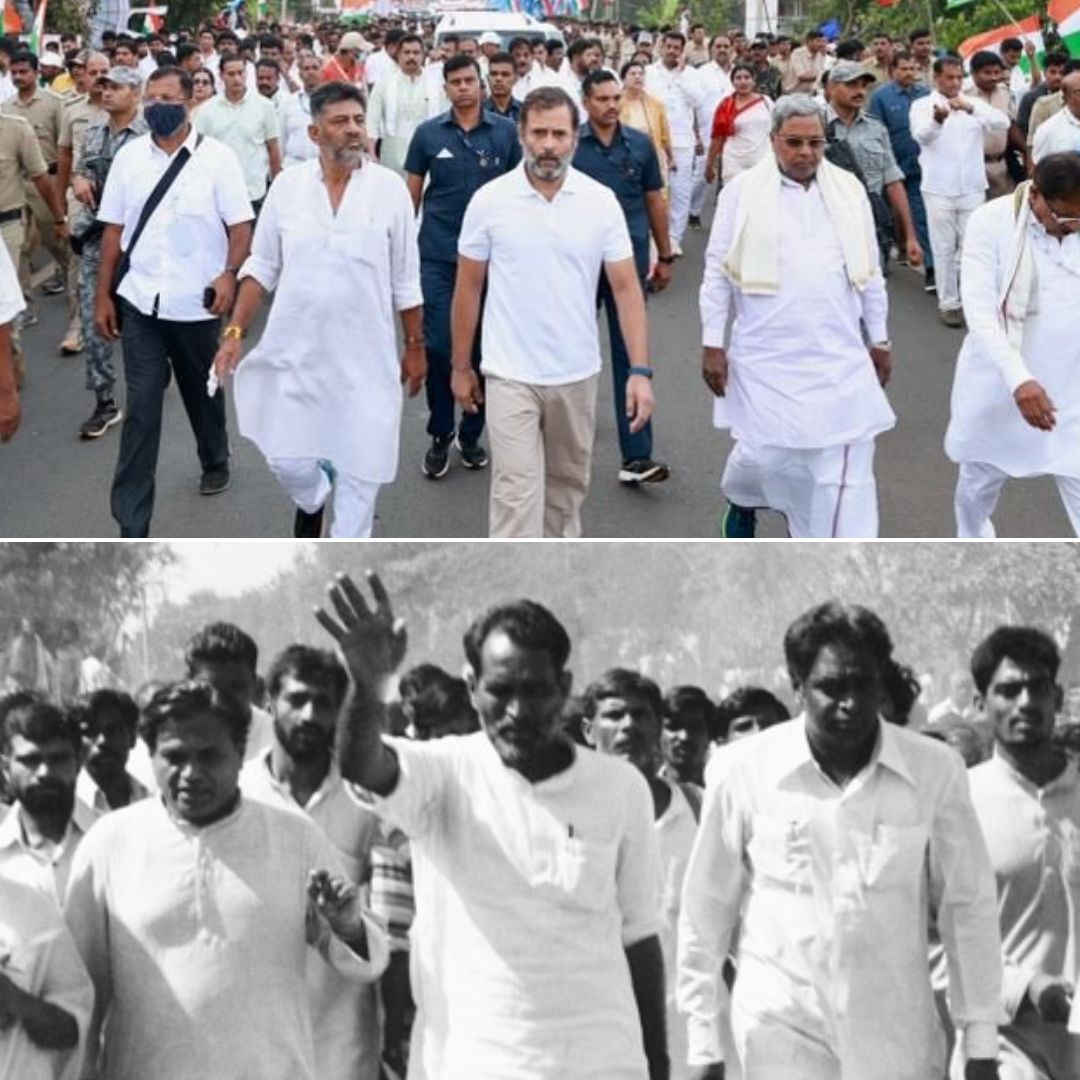
Image Credits: Twitter/ Jairam Ramesh, Chandrashekhar Photos
Bharat Jodo Yatra: Looking Back At History Of Long Walks That Transformed Politics In India
Writer: Ronit Kumar Singh
A confident and reliable journalist who always desires to toss the unheard voices. I cover politics and governance extensively through stories.
India, 10 Oct 2022 3:50 AM GMT
Editor : Shiva Chaudhary |
A post-graduate in Journalism and Mass Communication with relevant skills, specialising in content editing & writing. I believe in the precise dissemination of information based on facts to the public.
Creatives : Ronit Kumar Singh
A confident and reliable journalist who always desires to toss the unheard voices. I cover politics and governance extensively through stories.
The long walks conducted by political parties and leaders in Indian history have revived many people's careers. With their 3,700 Km long Bharat Jodo Yatra, the Congress also hopes for a turnaround in the 2024 polls.
The Congress-led Bharat Jodo Yatra is to change people's perspectives about the party and its leaders. In Indian history, similar long walks have been organised with the intent to bring change, politically and electorally. With the Bharat Jodo Yatra, the Congress party also expects the same as it has suffered through significant challenges in the last eight years since Modified nation ruled.
Many political leaders from the opposition alleged that Congress leadership is not adjustable to Indian politics as it requires grassroots-level governance with a lot of hard work. The Bharat Jodo Yatra, a 3,700 Km walk from south to north India, only aims to reinvent the image of the Congress party and its prominent faces, 'The Gandhis.'
The situation for Congress hasn't worsened only after the 2014 general elections, but the crisis was there between 1998 and 2004, too, when Bharatiya Janata Party (BJP) returned to power. However, the latest electoral drought for the Congress was the 2014 and 2019 general elections, where it faced massive defeat from the BJP-led National Democratic Alliance (NDA).
Along with the hope to make a comeback in electoral politics, the Bharat Jodo Yatra is crucial for the Gandhi's. Several questions come under the spotlight- Can Rahul Gandhi reintroduce himself as a leader in Indian politics? Will Congress regain its popularity? Is Bharat Jodo Yatra building connections with voters of India? The answer to such questions will only be given in the coming months. Let's look back at the history of long walks that transformed electoral politics in India.
Chandra Shekhar's 4,200 Km 'Bharat Yatra'
The socialist leader Chandra Shekhar took 4,200 Km long Bharat Yatra in 1983 against the former Prime Minister Indira Gandhi, who came to government after defeating his Janata Party.
The Bharat Yatra aimed to bring confidence among the people and trust for Janata Party. He completed the four-month-long padayatra from Kanyakumari and Delhi. Chandra Shekhar was in Haryana when Indira Gandhi was assassinated, The Indian Express reported.
YS Rajasekhara Reddy's 1,500 Km 'Praja Prasthanam'
The electoral condition of the Congress party was not in a good state during 2002-2003 in Andhra Pradesh. The regional organisation, Telugu Desam Party (TDP), ruled the state for several decades and Congress leaders like YS Rajasekhara Reddy never got an opportunity to come into power.
He understood that a padayatra is the only possible medium to connect with the people at the grassroots level. He undertook a 1,500 Km long padayatra known as 'Praja Prasthanam.' He walked during the summer for two months and covered several districts of his state to bring trust among the people. His effort brought change among the people as they ruled out TDP's Chandrababu Naidu and voted for Reddy as the Chief Minister of Andhra Pradesh in 2004. In a tragic incident, he died in a chopper crash in the same year.
Chandrababu Naidu's 2,800 Km 'Vastunna Meekosam'
Chandrababu Naidu was defeated by the YS Rajasekhara Reddy in 2004 through his padayatra and defeated TDP again in 2009. In the assembly polls of 2013, Naidu also adopted the same strategy and did a 208-day walkathon known as Vastunna Meekosam, covering 2,800 Km. The aim was to reinvent him as the leader of Andhra Pradesh after facing two defeats from Congress.
Through Vastunna Meekosam, Naidu brought his party back to power in the 2014 assembly elections. The same year, Telangana, a new state, was taken out from Andhra Pradesh, and K Chandrashekar Rao was elected as the Chief Minister.
Digvijaya Singh's 3,300 Km Yatra
The senior Congress leader and former chief minister of Madhya Pradesh, Digvijaya Singh, undertook a 3,300 Km yatra, calling it non-political. He walked through the banks of the Narmada river in 2017, telling people that it's a spiritual and religious walk. However, it was prominent that he had a mass connection and communication with people in rural areas. The six-month-long walk significantly impacted the electoral politics of Madhya Pradesh.
The Congress party defeated the BJP in the 2018 assembly elections, and Kamal Nath became the state's new Chief Minister. However, rebel Jyotiraditya Scindia left the Congress and joined BJP, which unseated Kamal Nath. But it benefitted Digvijay Singh to a great extent as he was the top choice for the opposition's candidate in the presidential election.
Also Read: From Borrowing Rs 500 To Owning Large Scale Business, This Women From UP Sets An Example For Many
 All section
All section














